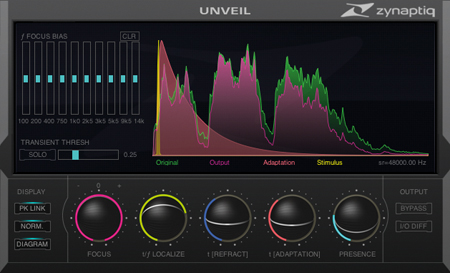Zynaptiq UNVEIL Review
Long-held views on what can and can’t be done with audio are being redefined. Liam O’Mullane spots another game-changer.


Keep It Simple
The main de-reverberation controls span five trackball faders. These look like circles and actually function just like any normal fader controlled by a mouse or automation, except they are designed this way to be compact within the interface.
The Focus control enables you to swing anywhere between the two extremes of how dry or wet you want your processed audio to be. A ten-band set of EQ sliders enables you to either focus or ignore reverb in certain frequency areas. To be honest, though, we found that we didn’t need to use it on our test material.
The IO DIFF button located on the very right of the interface enables you to hear the opposite of what you’re currently focusing on. This is particularly handy as it enables you to hear what Unveil is classing as the reverberation signal. You can then make sure that dry elements or transients are not present.
t/f LOCALIZE is another frequency focus-type of tool that lets you apply a broad treatment or focus in on smaller areas at the potential cost of hearing processing artefacts. t[REFRACT] enables you to control how sensitive the reverb control is to changes over time, while t[ADAPTION] determines the recovery time that elapses before the signal is next analysed, acting over time much like a standard compressor’s release control.
Finally, the PRESENCE trackball enables you to control the top end balance, brightening things up a bit after processing, as when the reverb is removed, things can start to sound a little dull.
Possible processing
There are plenty of situations in which you might want to remove or re-balance the amount of reverberation in a recording. You might, for example, have different recordings from a multi-camera piece of footage, and you want the perceived distance of an actor’s voice to remain constant. Unveil can be used on each audio track, allowing you to achieve this balance. However, it is heavy on CPU resources, so quad-cores and above are recommended for more than a few instances.
Throughout our testing we used dialogue, amped guitar recordings and a wide variety of samples packs to see how well Unveil performed. The results were excellent and we found it quite hard to get noticeable artefacts. Its real strength lies in how well it focuses on reverb despite continuously changing information, such as on a vocal track. We explored various acapellas and managed to remove nearly all the reverb without any drastic changes to the sonic qualities of the dry vocals.
We also went through various classic drum breaks and found we could achieve a much more modern drum sound as we removed the ambience, leaving some dry and incredibly focused hits to work with.
In general we struggled to find sources that Unveil couldn’t deal effectively with. Even if there isn’t much noticeable reverb on a track, it doubled as a way of getting an incredibly upfront and tight focus to any sound in a mix. It lacks an output level, however, so we applied a gain plug-in afterwards. This, plus releases of Unveil in VST and RTAS formats, should be addressed in a forthcoming update.
Verdict
+ Very effective de-reverberation
+ Great for sample processing
+ Preserves stereo information
– No input or output level controls
– AU plug-in only
– Heavy CPU demands
A very handy and highly effective plug-in to have in your audio toolbox. Great for anyone wanting to re-balance or remove existing ambience within a recorded file.
9/10


